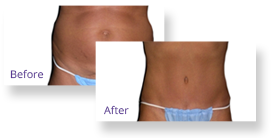Fat Grafting Minneapolis
Also known as fat grafting or fat injection

A fat grafting procedure transfers fat from areas in which you have excess fat, such as the outer thighs, and injects it into areas that may be lacking in volume, such as your face, hands, breasts or buttocks. This safe, long-lasting, well-tolerated procedure produces natural-looking results. Every year, thousands of people undergo successful fat grafting and are pleased with the results.
When to Consider Fat Transfer
- If you have facial areas that appear creased and sunken
- If you desire more permanent correction than is provided by temporary fillers
- If you wish to improve your body contour, revise scars, fill bodily depressions and rejuvenate your hands and face
- For use in breast reconstruction, to fill in contour irregularities or hide obvious signs of breast implants
Considerations
Pros
- Autologous fat (from your own body), as opposed to dermal fillers, replaces “like with like,” reducing the chance of allergic reactions to foreign substances.
- Fat transfer results are natural, long lasting and safe.
- Fat transfer is a noninvasive method for achieving facial rejuvenation.
Cons
- It is time consuming to prepare fat tissue before transferring it, compared to dermal fillers, which are prepackaged.
- Though longer lasting than dermal fillers, fat transfer costs more.
- For augmentation, you may require multiple sessions to achieve your desired breast or buttock size.
These are the top three pros and cons to weigh when considering fat transfer. If you wish to focus on what is unique to you, please consult with your aesthetic plastic surgeon.
Are you a good candidate for a fat transfer?
The purpose of fat grafting is to augment or fill in volume-deficient areas. Commonly grafted, or injected, areas include the hands, face (including the lips), depressions in the skin (following liposuction and scarring) and the breast and buttock (for augmentation). Of course, you must have donor sites from which fat can be taken. It is important that you do not have any circulation problems, either from a medical condition or smoking.
Facial fat transfer: If you have facial creases, such as laugh lines, smile lines, and crow’s-feet, fat can be removed from your abdomen, thighs, or other areas and be injected into your face. Acne scars and sunken areas of the face, lips, and cheeks can also be filled in. Your plastic surgeon can even use grafted fat to minimize lines between your nose and mouth, correct skin depressions or indentations and minimize forehead wrinkles.
Breast augmentation: If you desire a modest increase in breast size, you are a good candidate for fat grafting to the breast, but your breasts should already have a nice shape and good skin tone. If you have poor skin, sagging breasts, or want a significant increase in breast size, breast augmentation with fat transfer is not for you. The problem with only using fat for breast enhancement lies in getting large volumes of fat to predictably “take.”
Breast implants plus fat grafting: If your breast shape needs optimizing during a breast implant procedure, fat grafting can be useful. If you have residual breast irregularities after undergoing breast augmentation with implants, the irregularities can be filled in with fat to produce a smooth contour and an optimal shape.
Breast reconstruction with fat grafting: If you have breast defects following lumpectomy for breast cancer, fat grafting is an effective method for filling in these defects. Fat grafting is also an option for total breast reconstruction following mastectomy; however, to achieve sufficient breast volume, this is usually a multistage process that requires at least two to four sequential fat grafting procedures.
Buttock augmentation with fat grafting: Many people who desire a fuller, more rounded buttock will opt for a “Brazilian butt lift,” which uses fat transfer to provide a more curvaceous buttock without the use of an implant. Liposuction is commonly used to both sculpt the surrounding area and collect the autologous fat to be injected.
Hand rejuvenation with fat grafting: Fat grafting into your hands is effective for adding volume, “plumping up” wrinkled areas, covering underlying vessels and tendons and improving the quality of your skin over time.
If you are in good general health, have a positive attitude and realistic expectations, you are most likely a good candidate for this procedure.
Detailed Procedural Info
How is a fat transfer procedure performed?
Fat is harvested from one part of your body, washed and purified, and then carefully reinjected with specially designed needles into the areas that need augmentation. It may be necessary to repeat the fat grafting procedure several times to achieve the desired result. Fat grafting can be explained as a three-stage process: (1) harvesting (2) purification and transfer and (3) placement.
Harvesting: You and your surgeon will select a site for fat removal and will inject it with a local anesthetic. Your surgeon will then create a small incision in the area for fat removal and, using a sterile technique, insert a cannula connected to a syringe to carefully extract fat (liposuction).
Purification and transfer: Once enough fat is obtained from the donor area, your surgeon will process it to prepare the fat cells for transfer to small syringes that will be used for fat injection. Purification may require the use of a centrifuge to spin the fat or a filtration process to remove impurities.
Placement: The area designated to receive the graft will then be prepared. Your surgeon will insert a needle or cannula into the incision point of the site being augmented. The injection needle is usually passed in and out of the areas to be augmented multiple times. Each time the needle or cannula is withdrawn, a line of fatty tissue parcels is carefully deposited in natural tissue planes. This process is repeated until the desired correction has been achieved, creating a grid of grafted fat. Some surgeons recommend massaging the grafted areas to create a satisfactory contour. Others prefer to rely on the placement technique to create the appropriate contour. The surgeon may also place a dressing or bandage over the grafted area.
The goal of your aesthetic plastic surgeon and the entire staff is to help you achieve the most beautiful and natural-looking results, as well as to make your surgical experience as easy and comfortable as possible.
What are my options?
Your own fat may be used to alter your body contour, revise scars, fill depressions created by liposuction or cancer surgery and rejuvenate your hands and face. Common sites for obtaining fat include the abdomen and the flanks (love handles), posterior arms and the hips and thighs. The options your plastic surgeon will discuss with you are:
- Which areas will benefit from fat transfer?
- Which areas are best for fat removal?
- Whether any other procedures are appropriate?
-
A. Fat can be harvested from areas like the thighs and buttocks.
B. Fat can then injected into the lips (pictured) and elsewhere on the face.
What will my fat transfer incisions and scars be like?
Your only scars may result from liposuction, which is used to remove fat from the donor site.
- Because liposuction incisions are small, the scars are also small and are placed in hidden areas. Sometimes depending on the location of fat deposits on your body, the incisions cannot be hidden.
- The amount or degree of scarring depends on the surgeon’s technique and your genetic tendencies.
- Most liposuction scars fade and are barely perceptible over time. Visible scars are more likely when large liposuction cannulas are used and in patients who have darkly pigmented skin.
- There are two types of marks that can remain on the skin after liposuction. One is a true scar, and the other is known as dyschromia, a dark (hyperpigmented) or light (hypopigmented) spot on the skin.





